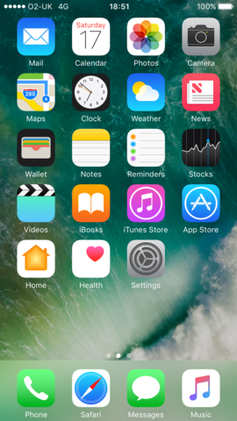
Back آي أو إس 10 Arabic ئای ئۆ ئێس ١٠ CKB IOS 10 German IOS 10 Greek IOS 10 Spanish IOS 10 Estonian آیاواس ۱۰ Persian IOS 10 French IOS 10 HE IOS 10 Armenian
| Version of the iOS operating system | |
 | |
 iOS 10 home screen running on an iPhone 6. The Videos app was replaced by the TV app in iOS 10.2 in the United States. | |
| Developer | Apple Inc. |
|---|---|
| Source model | Closed, with open-source components |
| Initial release | September 13, 2016 |
| Latest release | 10.3.4 (14G61)[1] / July 22, 2019 |
| Update method | Software Update |
| Package manager | App Store |
| Platforms | |
| Kernel type | Hybrid (XNU) |
| License | Proprietary software with open-source components |
| Preceded by | iOS 9 |
| Succeeded by | iOS 11 |
| Official website | iOS 10 – Apple at the Wayback Machine (archived September 12, 2017) |
| Tagline | More personal. More powerful. More playful. |
| Support status | |
| Obsolete, unsupported. Drops support for all A5 and A5X chips, including the iPhone 4s, iPad 2 and 3rd generation, iPad mini (1st generation), and iPod Touch (5th generation). | |
iOS 10 is the tenth major release of the iOS mobile operating system developed by Apple Inc., being the successor to iOS 9. It was announced at the company's Worldwide Developers Conference on June 13, 2016, and was released on September 13, that year. It was succeeded by iOS 11 on September 19, 2017.[2]
iOS 10 incorporates changes to 3D Touch and the lock screen. There are new features to some apps: Messages has additional emojis and third-party apps can extend functionality in iMessage, Maps has a redesigned interface and additional third-party functions, the Home app manages "HomeKit"-enabled accessories, Photos has algorithmic search and categorization of media known as "Memories", and Siri is compatible with third-party app-specific requests, such as starting workouts apps, sending IMs, using Lyft or Uber or to use payment functions. In iOS 10.3, Apple introduced its new file system, APFS.
Reviews of iOS 10 were positive. Reviewers highlighted the significant updates to iMessage, Siri, Photos, 3D Touch, and the lock screen as welcome changes. The third-party extension support to iMessage meant it was "becoming a platform," although the user interface was criticized for being difficult to understand. Third-party integration in Siri was "great," although the voice assistant was criticized for not having become smarter than before. Reviewers were impressed with the image recognition technology in Photos, although noting it was still a "work in progress" with a higher error rate than the competition. 3D Touch "finally feels useful" and "works in almost every part of the OS." The lock screen was "far more customizable than before," and reviewers enjoyed that notification bubbles could be expanded to see more information without needing to unlock the phone.
A month after release, iOS 10 was installed on 54% of iOS devices, a "slightly slower migration" than for the release of iOS 9, speculated as being caused by an early release issue that may have "put some users off downloading the update." User adoption of iOS 10 steadily increased in the following months, eventually totaling 89% of active devices in September 2017.
iOS 10 is the final version of iOS that supports 32-bit devices, including the iPhone 5, iPhone 5c, and the fourth-generation iPad, as its successor, iOS 11, drops support for those models. iOS 10 is also the final iOS version to support 32-bit applications.
- ^ Clover, Juli (July 22, 2019). "Apple Releases iOS 9.3.6 and iOS 10.3.4 With GPS Bug Fix for Older iPhones and iPads". www.macrumors.com. Archived from the original on July 22, 2019. Retrieved July 22, 2019.
- ^ Clover, Juli (September 19, 2017). "Apple Releases iOS 11 With Revamped Lock Screen, Fresh App Store, New Siri Voice, and Updated iPad Interface". MacRumors. Archived from the original on September 20, 2017. Retrieved September 19, 2017.